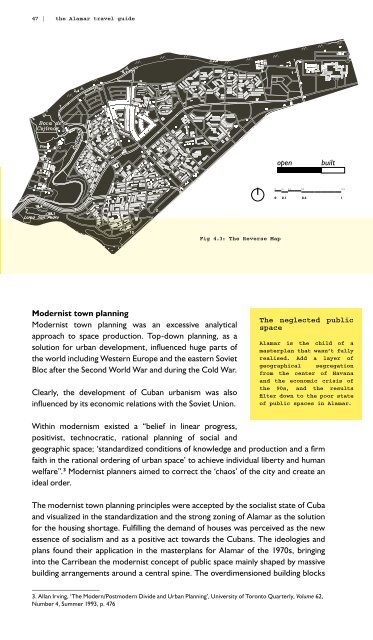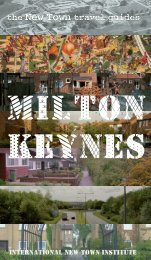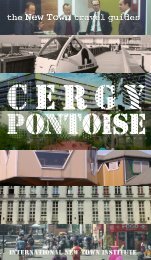Create successful ePaper yourself
Turn your PDF publications into a flip-book with our unique Google optimized e-Paper software.
0 0.1 0.2 0.4 1km<br />
47 | the <strong>Alamar</strong> travel guide<br />
open<br />
built<br />
0 0.1 0.4 1<br />
Fig 4.3: The Reverse Map<br />
Modernist town planning<br />
Modernist town planning was an excessive analytical<br />
approach to space production. Top-down planning, as a<br />
solution for urban development, influenced huge parts of<br />
the world including Western Europe and the eastern Soviet<br />
Bloc after the Second World War and during the Cold War.<br />
Clearly, the development of Cuban urbanism was also<br />
influenced by its economic relations with the Soviet Union.<br />
The neglected public<br />
space<br />
<strong>Alamar</strong> is the child of a<br />
masterplan that wasn’t fully<br />
realised. Add a layer of<br />
geographical segregation<br />
from the center of Havana<br />
and the economic crisis of<br />
the 90s, and the results<br />
filter down to the poor state<br />
of public spaces in <strong>Alamar</strong>.<br />
Within modernism existed a “belief in linear progress,<br />
positivist, technocratic, rational planning of social and<br />
geographic space; ‘standardized conditions of knowledge and production and a firm<br />
faith in the rational ordering of urban space’ to achieve individual liberty and human<br />
welfare”. 3 Modernist planners aimed to correct the ‘chaos’ of the city and create an<br />
ideal order.<br />
The modernist town planning principles were accepted by the socialist state of Cuba<br />
and visualized in the standardization and the strong zoning of <strong>Alamar</strong> as the solution<br />
for the housing shortage. Fulfilling the demand of houses was perceived as the new<br />
essence of socialism and as a positive act towards the Cubans. The ideologies and<br />
plans found their application in the masterplans for <strong>Alamar</strong> of the 1970s, bringing<br />
into the Carribean the modernist concept of public space mainly shaped by massive<br />
building arrangements around a central spine. The overdimensioned building blocks<br />
3. Allan Irving, ‘The Modern/Postmodern Divide and Urban Planning’, University of Toronto Quarterly, Volume 62,<br />
Number 4, Summer 1993, p. 476




